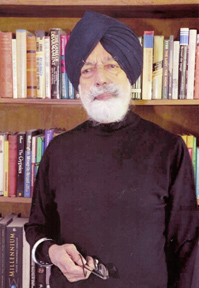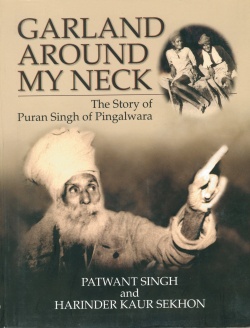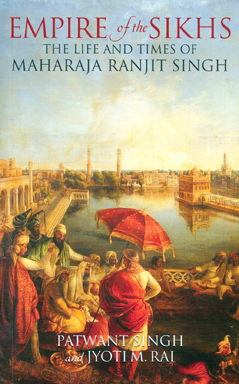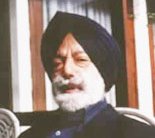Patwant Singh
Sadly, Bhai Patwant Singh ji passed away on Saturday, August 8, 2009. He was aged 84.
Bhai Patwant Singh (March 28, 1925 - August 8, 2009) was a famous Sikh writer, commentator, journalist, editor and publisher, as well as a frequent TV presenter. He was born in New Delhi on March 28, 1925. He grew up and carried out his school and University education in Delhi. He began his career in the family business of building and engineering but soon merged these interests with his love for writing. He started up his first periodical, The Indian Builder, in 1953 as publisher. In 1957, he unveiled his most influential journal, Design, the only magazine of its kind in the world at that time.
Design was a revolutionary magazine which brought together the latest thinking in the fields of architecture, urban planning, visual arts, graphics, and industrial design. Subject areas that, up to that point, had tended to have isolated audiences that rarely looked at or understood each other's fields. The journal’s strongly interdisciplinary approach led Singh to begin pondering questions about why Bombay, Delhi and other urban areas in India were being developed in ways that ran counter to his aesthetic and humanitarian sensibilities. When he realized that the answers had less to do with architecture and more to do with politicians, government policies and corruption, he began publishing newspaper articles in the 1960s with the aim of affecting public opinion and official policies.
Background
The Sino-Indian War of 1962 and the Second Kashmir War in 1965 led Singh to think about international politics and India’s place in the world. These concerns are reflected in the focus of his first book, India and the Future of Asia, published in 1967. His second book, 1971’s The Struggle for Power in Asia, was intended as a corrective to the narrow and skewed perspectives of the west on Asia and its influence on the world. According to Singh, "The tragedy of our time is that instead of turning to the Asians to find out what they think . . . Western opinion on Asia [continues] to be shaped by Western minds, catering to Western needs."
In 1973, Patwant Singh bought eight acres of land in the Aravalli Hills in Haryana. While on the road looking for land to buy, he was flagged down by a small group of people by the side of the road. A young woman was in labor and experiencing complications beyond the level of expertise of her midwife, so her family was trying to get her to a hospital in the nearest town. Patwant Singh immediately resolved to build a hospital there. He persuaded some fellow trustees of a small trust to fund the idea and arranged for the state of Haryana to donate land for this purpose. When Singh had a massive heart attack in 1977, his appreciation for the quality medical care he received led him to strengthen his resolve to build the rural hospital. Donors in India were joined by supporters in the US and Canada as well as even the Canadian International Development Agency, and with their support, the Kabliji Hospital and Rural Health Centre was built.
After 1984, Patwant Singh began to delve into Sikh issues, editing and contributing the opening essay of Punjab: The Fatal Miscalculation, which was published in 1985. The Golden Temple, published in 1989, aimed to be the definitive volume on the Harimandir Sahib and show how central this "fountainhead of inspiration" has been to Sikhs since its construction.
Of Dreams and Demons is Patwant Singh’s 1994 memoir, which highlights the intersections that connect his personal history to India’s history in the 1930s to the 1990s. He returned to the topics of religion and history with his 1999 publication, The Sikhs, a survey of Sikh history beginning with the historical context of South Asia before the time of the Gurus and stretching to the present day.
Garland Around My Neck was published at the beginning of March, 2001. It the remarkable story of Bhagat Puran Singh of Pingalwara. The book was co-written with Harinder Kaur Sekhon as a tribute to the remarkable humanitarian, Puran Singh who dedicated his life to sewa in order to bring a more healthy and humane world into existence. It is the real life story of Puran Singh (1904-92), a barefoot colossus who cared for the despairing, disabled and destitute with his own hands restoring to them the dignity of human existence that an uncaring society had denied them. After 23 years of personally caring for ever-increasing numbers of people who were unable to take care of themselves, in 1957, Puran Singh expanded his service to society by establishing Pingalwara, which now serves over 1,000 residents. Unlike a hospital, which has the aim of treating the sick, Pingalwara was built for people--disabled, poor, mentally ill, with terminal diseases--who needed hope and a home. Patwant Singh and Harinder Kaur Sekhon relied on Punjab’s rich tradition of oral history in researching this book.
In 2005, Patwant Singh’s book The World According to Washington: An Asian View, was published. In this work, the author examines the often violent history of relations between western imperial powers and Asia, including East Asia, South Asia, and West Asia. His perspective is passionately critical of the destruction western interventionists have wrought in Asia, largely through valuing their own political and economic interests over the interests of Asians themselves--and by backing up these interests with firepower. First, Singh writes, there was a time when "Europeans considered the domination of Asia their birthright."
Now, incursions of US troops, US-made arms, and coercive development plans are the strategies of the world’s only remaining superpower. When Washington, DC and those in its pocket write history and cover current events, their perspective is so imbalanced that the general public in the western world is now ignorant of even the most basic facts about Asia. The World According to Washington was conceived as a corrective and fills in the missing histories of US involvement and interests in hotspots such as—Iran, Indonesia, Korea, Vietnam, Laos, Cambodia, India and Pakistan.
Patwant Singh has also written extensively for newspapers and magazines and has appeared on both radio and television. His articles have appeared in many publications including the New York Times, Canada’s Globe and Mail, the UK’s Independent. Patwant Singh gave a lecture on July 22, 2006 at the Rubin Museum of Art in New York in conjunction with, I See No Stranger: Early Sikh Art and Devotion, an exhibition jointly sponsored by the Sikh Foundation and the Sikh Art and Film Foundation.
His latest book and now sadly his last book was just launched a month and half ago in Washington DC on June 18 and 19, 2009 at The Library of Congress Asian Division as part of the National Sikh Conference, Taking Heritage into the 21st Century celebrations. "Empire of the Sikhs - The Life and Times of Maharaja Ranjit Singh" by Patwant Singh & Jyoti Rai is about the Sikh ruler, Maharaja Ranjit Singh (1780-1839). The book deals with this glorious history of the Sikhs and has been largely written out of accounts of India's past by British historians. It highlights the Maharaja as one of the most powerful and charismatic figures in Indian history; how he unified the warring chiefdoms of the Punjab into an extraordinary northern empire stretching the borders of Kabul and Tibet, built up a formidable army, kept the British in check to the south of his realm, and closed the Khyber Pass through which plunderers had for centuries poured into India.
The book describes how the Maharaja's "consummate humanity was unique among empire-builders. He gave employment to defeated foes, honored faiths other than his own, and included Hindus and Muslims among his ministers. Inspired by the principles of peaceful coexistence uniquely articulated by the Sikh Gurus and firm in upholding the rights of others, he was unabashed in exercising his own. His court was renowned for its splendor; he had around twenty wives, kept a regiment of 'Amazons' and possessed a stable of thousands of horses."
The authors of this first full-length biography in English make use of a variety of eye-witness accounts, from reports by Maratha spies at the Lahore Durbar to British parliamentary papers and travel accounts. The story ends with the controversial Anglo-Sikh Wars following Ranjit's death, which saw the fall of his empire in the hands of his successors whose internecine conflict was exploited by the British.
Other Works
He has written extensively on international affairs. The first book, India and the Future of Asia, was published in 1967 by Knopf in the US and Faber and Faber in the UK. It was also excerpted at length by the magazine, Life International.
In 1971 Hutchinson published The Struggle for Power in Asia. The French edition of this book, by Editions Andre Gerard-Marabout, was published in 1974. The title of the French Edition was Le Jeu Des Puissances En Asie.
He edited as well as wrote the opening essay for the book, Punjab: The Fatal Miscalculation, which was published in 1985. It mapped the manner in which Sikhs were alienated by the political miscalculations of the government in New Delhi in large part because of its inability to understand - or accept – their ideals and beliefs. For that reason, from around the early eighties till the late nineties, almost the entire focus of the books he wrote was on Sikhs and the Sikh religion.
The Golden Temple (a book on the fountainhead of the Sikh faith, the Gurudwara Harimandir Sahib in Amritsar) was published in 1989 by ET Publishing and Gurdwaras in India and Around the World in 1992 by Himalayan Books. (A Gurdwara is a Sikh place of worship).
Patwant Singh’s personal memoir, Of Dreams and Demons, was published in the UK in 1994 by Duckworth, and in India by Rupa. The US Edition was published in June 1995 by Kodansha Globe.
The Sikhs, was published in London by John Murray and in India by Harper Collins in March 1999 and in the US by Alfred Knopf and Canada by Random House in 2000. Doubleday published the paperback edition in the US, as did Rupa in India.
Patwant Singh writes extensively for newspapers and magazines and has chaired seminars, appeared on radio and television, and been interviewed on both on numerous occasions. Has has covered, in his columns and public appearances, a full range of subjects from national politics to international affairs, urbanism, the arts and other aspects of culture. His articles have appeared in The New York Times, Canada’s Globe and Mail, the UK’s Independent and elsewhere.
Editing Experience
Edited and published Design magazine from 1957 till 1988. Design covered architecture, urban planning, the visual arts and both graphic and industrial design. It was the only magazine of its kind in the world which covered all these subjects, not sporadically but with the definite aim of finding common denominators in the different arts for creating a total living environment.
Initiative in Rural Medicine & Education
As Chairman of a family Trust, Patwant Singh established a unique rural medical facility in the state of Haryana in 1977. The Kabliji Hospital and Rural Health Centre is today acknowledged as a one-of-a-kind initiative in providing medical coverage and promoting preventive health in rural India. It was born out of Patwant Singh's conviction that very little was being done for the medical and educational needs of the rural population in India, and that private initiative must play a role in providing these. A school was also founded next to the hospital a few years later. Both continue to flourish.
Travel
He has travelled to many countries, often as a guest of their governments. Among these are Germany, USA, UK, Sweden, Australia, Japan, Taiwan, Thailand, Vietnam, Indonesia, Malaysia and the Philippines.
Passed Away
Sikh writer, activist and philanthropist Patwant Singh is no more
New Delhi, India: Well known Sikh Writer and philanthropist Patwant Singh has passed away in the national capital following a cardiac arrest. He was 84. Singh, who died at his residence here yesterday, is survived by wife Meher and adopted son Satjiv Singh Chahil.
Singh wrote over 10 books on history, politics and international affairs. His latest 'Empire of the Sikhs: The Life and Times of Maharaja Ranjit Singh' was released in Washington DC on June 18. Educated in Delhi, Patwant Singh, who made headlines with path-breaking Design magazine before turning his focus to issues that the Sikh community was grappling with, authored a definitive biography of Bhagat Puran Singh and several books about Sikhs.
The cremation will be at 6 pm in Delhi on Saturday, Aug 8, at the Lodhi Road crematorium.
Patwant Singh was a much respected commentator on Sino-Indian War of 1962 and the Second Kashmir War in 1965. Since 1984, Patwant Singh delved deep into Sikh issues, editing and contributing the opening essay of Punjab: The Fatal Miscalculation, which was published in 1985. The Golden Temple, published in 1989, aimed to be the definitive volume on the Harimandir Sahib and show how central this "fountain of inspiration" has been to Sikhs since its construction.
Garland Around My Neck, the story of Bhagat Puran Singh, the barefoot soldier of remarkable humanitarian concerns was presented by Patwant Singh as a colossus that he was in real life.
Patwant Singh also wrote extensively for newspapers and magazines. Many in the US last remember him for his lecture on July 22, 2006 at the Rubin Museum of Art in New York in conjunction with, I See No Stranger: Early Sikh Art and Devotion, an exhibition jointly sponsored by the Sikh Foundation and the Sikh Art and Film Foundation.
His book The Sikhs, published in London by John Murray and in India by Harper Collins in March 1999 and in the US by Alfred Knopf and Canada by Random House in 2000, remains a best seller. Doubleday published the paperback edition in the US, as did Rupa in India. His articles appeared in The New York Times, Canada’s Globe and Mail, the UK’s Independent and elsewhere.
Source: [1]
Contact
- Mr. Patwant Singh, 11, Amrita Shergil Marg, New Delhi – 110 003.
- Telephone: 2463 1542 / 2461 7981 Fax: 2462 9553
- Website: www.patwantsingh.net
- Email: [email protected]
His books include
- India and the Future of Asia (Knopf; Faber and Faber, 1967)
- The Struggle for Power in Asia (Hutchinson, 1971; French edition Le Jeu des Puissances, André Gérard-Marabout, 1974)
- The Golden Temple (Time Books International, 1989)
- Gurdwaras in India and Around the World (Himalayan Books, 1992)
- Of Dreams and Demons: An Indian Memoir (Duckworth, 1994;
- Kodansha America, 2005)
- Garland Around my Neck: The Story of Puran Singh of Pingalwara (UBSPD, 2001)
- The Sikhs (John Murray; Knopf; Random House, 1999) Read Online THE SIKHS by Patwant Singh
- The World According to Washington (UGI Perspectives, 2004;
- Common Courage Press, 2005)
- The Second Partition: Fault-Lines in India’s Democracy (Hay House, 2007)
- Empire of the Sikhs Publication Date: June 18, 2009
See also




